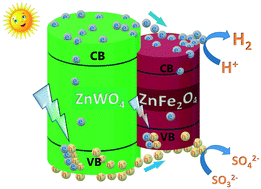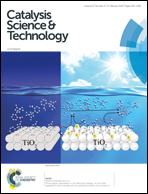Heterojunction ZnWO4/ZnFe2O4 composites with concerted effects and integrated properties for enhanced photocatalytic hydrogen evolution
Abstract
Hydrogen fuel generated via solar water splitting has been recognized as a promising green energy technique. In this study, a novel ZnWO4/ZnFe2O4 heterojunction composite was successfully prepared using a facile co-precipitation method for photocatalytic hydrogen evolution without using a noble metal co-catalyst. The as-prepared composites were well-characterized using PXRD, UV-vis-DRS, TEM and XPS to ascertain the successful deposition of the ZnFe2O4 nanoparticles onto the ZnWO4 flakes. During the photocatalytic hydrogen evolution experiments using Na2S and Na2SO3 as hole scavengers, ZnWO4/ZnFe2O4 (30 wt%) exhibited the best activity as compared to pure ZnWO4 and ZnFe2O4. The underlying reasons for the superior photocatalytic hydrogen evolution of the optimal composite were assessed based on the inextricably linked factors of light absorption, mobility and separation of charge carriers, and redox potentials using photoluminescence, time-resolved fluorescence lifetime and electrochemical impedance spectroscopy measurements. The photochemical durability of the ZnWO4/ZnFe2O4 heterojunction composite signifies its suitability for practical applications.



 Please wait while we load your content...
Please wait while we load your content...